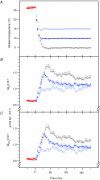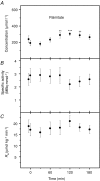Fuel selection in Wistar rats exposed to cold: shivering thermogenesis diverts fatty acids from re-esterification to oxidation
- PMID: 19622609
- PMCID: PMC2754371
- DOI: 10.1113/jphysiol.2009.175331
Fuel selection in Wistar rats exposed to cold: shivering thermogenesis diverts fatty acids from re-esterification to oxidation
Abstract
This study characterizes the effects of shivering thermogenesis on metabolic fuel selection in Wistar rats. Because lipids account for most of the heat produced, we have investigated: (1) whether the rate of appearance of non-esterified fatty acids (R(a) NEFAs) is stimulated by shivering, (2) whether mono-unsaturated (oleate) and saturated fatty acids (palmitate) are affected similarly, and (3) whether the partitioning between fatty acid oxidation and re-esterification is altered by cold exposure. Fuel oxidation was measured by indirect calorimetry and fatty acid mobilization by continuous infusion of 9,10-[(3)H]oleate and 1-[(14)C]palmitate. During steady-state cold exposure, results show that total heat production is unequally shared by the oxidation of lipids (52% of metabolic rate), carbohydrates (35%) and proteins (13%), and that the same fuel selection pattern is observed at all shivering intensities. All previous research shows that mammals stimulate R(a) NEFA to support exercise or shivering. In contrast, results reveal that the R(a) NEFA of the rat remains constant during cold exposure (55 micromol kg(1) min(1)). No preferential use of mono-unsaturated over saturated fatty acids could be demonstrated. The rat decreases its rate of fatty acid re-esterification from 48.4 +/- 6.4 to 19.6 +/- 6.3 micromol kg(1) min(1) to provide energy to shivering muscles. This study is the first to show that mammals do not only increase fatty acid availability for oxidation by stimulating R(a) NEFA. Reallocation of fatty acids from re-esterification to oxidation is a novel, alternative strategy used by the rat to support shivering.
Figures

 ) accounted for by carbohydrate (A) and lipid (B) oxidation in male Wistar rats before (27°C, thermoneutral control) and during cold exposure (15°C, ◊; 10°C, •; 5°C, ▿). Values are means ±
) accounted for by carbohydrate (A) and lipid (B) oxidation in male Wistar rats before (27°C, thermoneutral control) and during cold exposure (15°C, ◊; 10°C, •; 5°C, ▿). Values are means ±
 ) (B) and carbon dioxide production (
) (B) and carbon dioxide production ( ) (C) of male Wistar rats before (27°C, thermoneutral control) and during cold exposure (15°C, ◊; 10°C, •; 5°C, ▿). Values are means ±
) (C) of male Wistar rats before (27°C, thermoneutral control) and during cold exposure (15°C, ◊; 10°C, •; 5°C, ▿). Values are means ±




Similar articles
-
Partitioning oxidative fuels during cold exposure in humans: muscle glycogen becomes dominant as shivering intensifies.J Physiol. 2005 Jul 1;566(Pt 1):247-56. doi: 10.1113/jphysiol.2005.086272. Epub 2005 Apr 14. J Physiol. 2005. PMID: 15831534 Free PMC article. Clinical Trial.
-
Oxidative fuel selection and shivering thermogenesis during a 12- and 24-h cold-survival simulation.J Appl Physiol (1985). 2016 Mar 15;120(6):640-8. doi: 10.1152/japplphysiol.00540.2015. Epub 2015 Dec 30. J Appl Physiol (1985). 2016. PMID: 26718783
-
Lipid mobilization of long-distance migrant birds in vivo: the high lipolytic rate of ruff sandpipers is not stimulated during shivering.J Exp Biol. 2007 Apr;210(Pt 7):1161-9. doi: 10.1242/jeb.003012. J Exp Biol. 2007. PMID: 17371915
-
Fuel selection in shivering humans.Acta Physiol Scand. 2005 Aug;184(4):319-29. doi: 10.1111/j.1365-201X.2005.01465.x. Acta Physiol Scand. 2005. PMID: 16026423 Review.
-
Shivering in the cold: from mechanisms of fuel selection to survival.J Appl Physiol (1985). 2006 May;100(5):1702-8. doi: 10.1152/japplphysiol.01088.2005. J Appl Physiol (1985). 2006. PMID: 16614367 Review.
Cited by
-
Convergent changes in muscle metabolism depend on duration of high-altitude ancestry across Andean waterfowl.Elife. 2020 Jul 30;9:e56259. doi: 10.7554/eLife.56259. Elife. 2020. PMID: 32729830 Free PMC article.
-
Time-of-Day Effects on Metabolic and Clock-Related Adjustments to Cold.Front Endocrinol (Lausanne). 2018 Apr 26;9:199. doi: 10.3389/fendo.2018.00199. eCollection 2018. Front Endocrinol (Lausanne). 2018. PMID: 29755411 Free PMC article.
-
Differential regulation of the unfolded protein response in outbred deer mice and susceptibility to metabolic disease.Dis Model Mech. 2019 Feb 27;12(2):dmm037242. doi: 10.1242/dmm.037242. Dis Model Mech. 2019. PMID: 30733237 Free PMC article.
-
Acclimation to hypoxia increases carbohydrate use during exercise in high-altitude deer mice.Am J Physiol Regul Integr Comp Physiol. 2017 Mar 1;312(3):R400-R411. doi: 10.1152/ajpregu.00365.2016. Epub 2017 Jan 11. Am J Physiol Regul Integr Comp Physiol. 2017. PMID: 28077391 Free PMC article.
-
Functional genomics of adaptation to hypoxic cold-stress in high-altitude deer mice: transcriptomic plasticity and thermogenic performance.Evolution. 2014 Jan;68(1):48-62. doi: 10.1111/evo.12257. Epub 2013 Sep 16. Evolution. 2014. PMID: 24102503 Free PMC article.
References
-
- Abdul-Malak N, Brichon G, Meister R, Zwingelstein G. Environmental temperature and metabolism of molecular species of phosphatidylcholine in the tissues of the rainbow trout. Lipids. 1989;24:318–324.
-
- Adán C, Ardévol A, Remesar X, Alemany M, Fernández-López JA. Hindleg muscle energy and substrate balances in cold-exposed rats. J Exp Biol. 1995;198:1243–1251. - PubMed
-
- Arola L, Herrera E, Alemany M. A method for the estimation of striated muscle mass in small laboratory animals. Rev Esp Fisiol. 1979;35:215–218. - PubMed
-
- Blem CR. Avian energy storage. Curr Ornithol. 1990;7:59–113.
Publication types
MeSH terms
Substances
LinkOut - more resources
Full Text Sources
Miscellaneous

